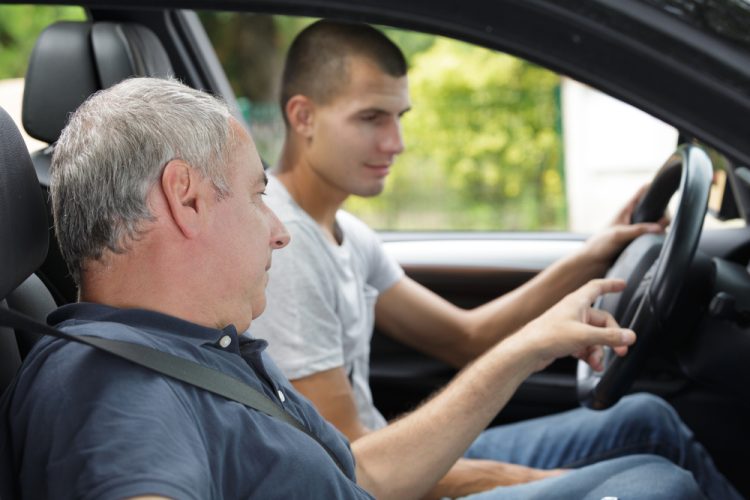
Your teen is ready to cross another milestone: Getting their driver’s license. Although it can be a stressful time in every parent’s life, there are ways to turn teaching a teenager how to drive into a more organized and relaxed event. All milestones have a bittersweet feeling to them, but this time with your son or daughter can be meaningful and, when done correctly, can ease your fears about putting your young driver behind the wheel.
As with all skills, there is a learning curve to feeling safe and comfortable when driving. Lots of practice is the best way to hone this particular skill set, so let’s jump in.
Setting Realistic Expectations
Your teenager wasn’t born with every skill set they’ll need to successfully navigate through life and the same holds true for driving. As a parent, you’ve had to spend time in many different ways to teach your children the necessary skills they need. So, you already know it’s a learning process that will take time. Young adults may act like they already know it all, but you know better.
When it comes to driving (and many other things), setting a good example and being a solid role model will go a long way when it’s time to get in the passenger seat and let your teen take over in the driver’s seat.
Getting to the Basics of Driving
As you are aware, there is more to driving than just getting behind the wheel and pressing the gas pedal. The first step is to help your soon-to-be-adult understand the reason for all the different parts and components of the vehicle, as well as explaining to them how auto insurance works.
As you probably already know, car insurance for new drivers is expensive. Due to their lack of experience and their collective tendency to file a higher number of claims, insurance companies typically consider them a high-risk group and charge accordingly. There are some ways you can save money when it comes time insure your teen driver.
It’s important for adolescents to understand their car insurance will go down if they keep a clean record. Drive this point home by letting your child research insurance quotes for those in their teens and those in the mid 20’s. They’ll be able to see how much cheaper car insurance can be if they are a safe driver.
Importance of Seatbelts and Mirrors
When you are explaining how the parts of a car work, don’t forget to examine the importance of always using a seatbelt and constantly checking your mirrors. Seatbelts are the law and they save lives. Being a proactive driver by always knowing what’s around you will go a long way to instilling confidence.
Vehicle Safety Features
Today’s vehicles come with a huge variety of safety features. Along with understanding the importance of seatbelts and mirrors, you should also discuss these features and how each one works:
- Dashboard: The many lights and sounds produced by the dashboard help keep an eye on the health of the vehicle’s systems and alert the driver when something is wrong.
- Steering wheel: A steering wheel is designed to be adjusted up and down to accommodate the driver and not impede the view of the dashboard.
- Seats: Your seat should be just far enough away from the steering wheel to drap your hand over at the wrist.
- Headlights: It’s important to know how to turn these on and off, as well as when to use them (beginning at dusk, in inclement weather) and how to use the bright lights.
- Parking brake: New drivers should understand how important it is to set the parking brake most of the time. This secondary braking system will help your primary system last longer since it takes a little pressure off. It is useful whether parking on an incline or a flat place.
- Newer safety features: May newer cars are equipped with safety features such as lane assistance and pedestrian warning.
It’s a good idea to take a lot of time to make sure your teen feels they have a solid understanding of how the car works.

Teaching Safe Driving Habits
In many places, those acquiring their driver’s licenses for the first time are required by state laws to attend driver’s education classes. A driving school is one of the best ways to ensure your family member is learning driving skills from a professional.
Although, as a parent, you can further your youth’s driving education with lots and lots of driving experience, having someone who sits in the passenger seat with an extra brake pedal teach those basic lessons can reduce stress for parent and child.
Most student drivers have these driving sessions while they are in high school. In most cases, young people may get a learner’s permit at the age of 15. Once they have accumulated a certain number of hours of classroom study and behind-the-wheel lessons, they can apply for their license at the age of 16.
Staying Focused Without Distractions
As mentioned, setting a respectable example as a parent is a great way to model safe driving. For instance, never use your cell phone while driving and emphasize to your son or daughter how driving without distractions is paramount. This includes no fiddling with the radio, talking, putting on makeup or anything else that takes their focus from the road.
Following Traffic Rules
There are federal, state and municipal traffic rules and there are rules of the road. Both of these are important to master. Depending on where you are driving, the speed limit may have been set by a state agency or a local one. The important thing to know is that these are not optional: These laws must be obeyed.
Rules of the road are important to learn, as well. These include things such as turning off your bright lights when approaching or coming up behind another driver and how to take your turn when other drivers are trying to get in a line. Take these things into account as an important part of how to teach your teen to drive.
Importance of Knowing Common Road Signs
Your student will need to study up on how to identify common road signs in order to pass the state driving test. These include stop signs, yield signs, speed limit signs and many more.
Gaining Confidence Behind the Wheel
As you know, we gain confidence when we become good at something. In most cases, this means practice. Many children today got their first lesson in driving at the go-kart track or some other theme-park ride. But true driving skills must be learned in real-world settings – and that’s where you, with your white knuckles over there in the passenger seat, come in.
Exposing your teen driver to a variety of settings they’ll likely encounter will hone their driving skills.
High Traffic and Defensive Driving
Driving in congested and stop-and-go traffic is one of the most nerve-wracking moments behind the wheel. One moment of distraction can lead to an at-fault rear-end collision. Similarly, not leaving enough space between yourself and other drivers is a recipe for disaster. These types of traffic situations are critical for learning about that all-important blind spot.
That’s why it’s important to get practice driving in these conditions and learn about defensive driving. In fact, taking a defensive driving course can help save money on a young driver’s insurance policy. And today, you can even take these online, making it super convenient and valuable.
Starting in a Controlled Environment is Best When Teaching Your Teen to Drive
We’ve all been there: Driving around in circles in a large, empty parking lot. This is one of the best ways to let a fledging boost their driving skills. With plenty of open space, a parking lot offers the ability to practice such things as:
- Coming to a complete stop at a stop sign without putting everybody through the front windshield.
- Driving in a straight line in between marked lanes.
- Making those left-hand turns without ending up in the ditch.
- Practicing maintaining speed limits.
- Practicing pulling into and backing into a parking space.
Remember, having these skills before heading out into traffic can really boost a teen’s confidence.
Different Weather and Road Conditions
After the parking lot, it’s time to get your young driver out into real-world conditions. This includes good weather and inclement weather. When it’s bright and sunny, your teen needs to learn about driving with the sun in their eyes or a glare. When it’s raining cats and dogs or snowing, they need to learn how to maneuver around slipping and sliding into someone else’s car.
Taking the time to practice on city streets, the highway and country roads will pay off in the long run. It could be fun to take your driver onto gravel roads and let them see what it’s like to stop suddenly in a slippery situation.
Learning How to Drive at Night
Driving at night is a whole ‘nother animal – even for the most experienced among us. We’ve all experienced the blinding light when oncoming traffic doesn’t dim their lights. Sometimes it’s hard to know where the lane ends and where it begins.

Preparing for the Driving Test
All new drivers must eventually take a driving test if they want to get a driver’s license. There are some areas of the test you’ll need to practice with your student driver, including parallel parking and the 3-point turn. Some other areas to include in your prep for the test are:
- Reviewing the testing criteria and requirements
- Conducting mock driving tests
- Addressing common mistakes and areas for improvement
The Road to Independence
Once your kid has their official license, you can set them free without a worry, right? Wrong. As a parent, you’ll probably always be worried about your teenager on the road – even after they have their own children. But if you follow the steps above, you’ll know you gave them a good starting place and their skill level will grow exponentially the more they drive.
So, set some guidelines around both the car and the driving, such as curfews and friends, and let them know you will always be there for them when needed.
Safe and Responsible Driving with Freeway Insurance’s Tips!
Finding the right insurance for your new driver can be hard. Coverage for young people is expensive. There are some steps you can take to lighten the burden. Keep in mind, if your child keeps a clean, safe driving record, their rates will drop as they get older. Meanwhile, check with Freeway Insurance for cheap car insurance for teens. You can get a free quote online, give us a call at (800) 777-5620 or stop by one of our convenient locations.



